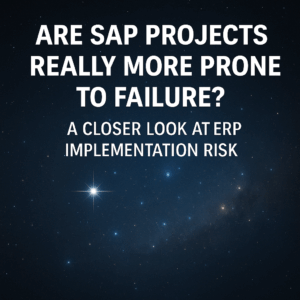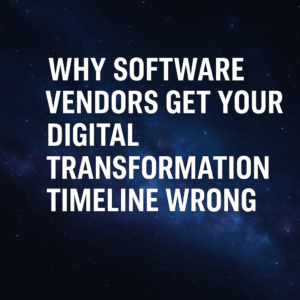When deploying a change management strategy for digital transformation, most organizations overlook the most important change strategies that are most likely to make a project successful but what exactly are those most overlooked chain strategies? That’s what we want to talk about in this article today.

People oftentimes don’t understand what exactly change management is, either they have a very myopic, limited view of change management, such as training communications being the extent of change management or they just have a very vague, ambiguous, approach to change management, which isn’t the right answer.
Rather than taking a random approach to change management and seeing what sticks, it’s important to look at the most important and the most overlooked strategies that are most likely to help make your project successful.
Table of Contents
ToggleOrganizational Assessment
The first most overlooked change strategy within digital Transformations is an organizational assessment. The reason organizational assessments are so important is because it helps you be more prescriptive and focused in how you deploy change management in your organization. It’s important that you don’t take a randomized approach to change management or take a one-size-fits-all approach to change management, what’s important is that you create a change strategy and plan that really fits your unique situation, where you are today and where you’re headed in the future.
One of the best ways to draw that out is through an organizational assessment. What the organizational assessment also does is it helps you identify the cultural nuances of your organization. It helps you proactively identify where the likely sources of resistance are going to be within the organization and where the most challenging parts of the transformation are going to be from an organizational perspective.
That organizational assessment is super important to helping provide some input into creating a strategy that’s tailored for your needs and typically when we do organizational assessments we have two aspects of it.
One is an anonymous employee survey that gathers quantitative data and then we have a series of qualitative focus groups that we do to gather that qualitative information and we combine the data sets from those two, we benchmark to other organizations and we look at what is unique to that organization and we use our experience to determine where we think the most resistant parts of the organization are going to be and where we really need to focus our time and effort.
It also gives us better input to understand what sorts of tactics are going to work best from a change management perspective so that organizational assessment is a commonly overlooked very critical part of an effective change management strategy.
Change Impact Assessment
The next most overlooked aspect of change management is the change impact assessment. What a change impact assessment is, is essentially looking at job by job and department by department, business location by business location, what the differences are between the way things are today and the way things are going to be in the future.
I can’t emphasize enough how often this is overlooked and how important this activity is. The reason it’s so important is because when you go to train people and communicate to them on what their new job is going to look like, you have to do it in the context of where they are today and help them connect the dots from what they understand and the nomenclature they use today, the systems and the spreadsheets they use today and what it’s going to look like in the new technological and business process environment.
Without that, you’re shooting in the dark, you’re guessing as to what it is you’re going to communicate and it’s not enough to simply say “this is what the future state’s going to be, here’s the new technology, go have at it and good luck !” We need to be much more thoughtful about it, much more deliberate in terms of how we help transition people from current state, to future state.
The only way we can do that is by doing a change impact assessment. The best time to do this change impact assessment is during the design or blueprint phase of your digital transformation. In other words, when you and the project team are defining what the future state business processes are going to be, that’s a great time to then do a gap analysis between that future state design of what the processes and technologies are going to be, versus what they are today. If you can be part of that discussion and part of those workshops, that’s probably the best time and place to capture and start to document and understand what the change impacts are going to be.

Organizational Design
Another commonly overlooked change strategy that’s very important to digital transformation success is organizational design. Organizational design essentially defines how job roles and responsibilities are going to look in the future and what the org chart is going to look like as well.
If you’re doing your job right and the digital transformation is adding the value that it should, it’s going to impact people’s jobs, it’s going to change their day-to-day roles, it might change their reporting relationships, it might change their understanding and visibility of different parts of the business and is probably going to rock people out of their comfort zone.
So having a clear vision of what that organizational design is going to be in the future is super important. It’s not enough just to train people on how to use technology. If you want to get the real business value out of this large investment that you’re making in technology, you want to make sure that you understand and articulate to people what their jobs are going to look like.
The problem with many technology deployments is that organizations don’t think through what we’re going to do with Susie’s job or the 40 percent of Susie’s job that we’re now automating or that spreadsheet that Johnny was using to run his part of the business for the last 20 years. The reason it’s so important is because we have to have that clarity to get the value that we expect out of the investment.
Johnny and Susie and the other people within the organization need to have that clarity as well or else they’re going to panic and they’re going to start to resist change. When you look at why people resist change, oftentimes, it’s uncertainty and lack of clarity, lack of vision, lack of understanding of why we’re doing this and what their job is going to look like in the future. As part of your change management strategy and plan, you want to make sure you have an organizational design work stream to address these and other activities.
We have talked in the past about how many organizational change strategies focus on training and communication, those are two very important work streams within an overall change management strategy but they’re just two very small parts of the overall change strategy. What’s even more important than just training people on how to use technology, is to focus on user adoption.
Not only do they know how to use the technology but have they embedded the business processes and the use of the technology into their DNA and into their comfort zone, so in other words, we don’t want to just give them a one-time classroom training and hope for the best when go live comes around, we want to make sure that we’ve really focused on user adoption and actually measuring user adoption too, not just what they do in a classroom but measuring what they actually do within a system, in a test environment or a training environment as well.
Digital adoption tools are a great way to address this risk. At Third Stage Consulting, we have a digital adoption tool that’s technology agnostic, that can be used with any sort of technology to provide tutorials and online guidance through a certain transaction or process so that even a go live environment, you’ve got these digital adoption tools that can help provide ongoing support for people.
Digital adoption tools can be a good stop gap and a good way to provide ongoing support during an implementation and even leading up to go live these digital adoption tools can be a great way to understand and measure how well people are adjusting to the new business processes and understanding those new business processes.
Benefits Realization and Optimization
The final overlooked change strategy that I want to talk about here today is benefits realization and optimization. The interesting thing about this is a lot of organizations have no idea that benefits realization and ROI is somehow tied to change management but it absolutely is.
When we’re doing change management activities, we’re not doing it just to feel good and to make everyone feel good about their place in life, we’re doing it because we want to add real business value to the organization and if we can’t connect those dots, then people are going to question the value of change management.
Benefits realization and optimization is a great way to not only ensure that change management is adding value but to ensure that the overall transformation is adding value. The way we tie benefits realization back to change management is to tie user adoption and users acceptance of the new technologies to ROI and to a business benefit business case.
When you’re thinking about change management strategies, even though it’s overlooked, even though a lot of organizations don’t do it, it’s really important to tie those activities to ROI, business value and business optimization as well.
Hopefully this has provided you some guidance on how to be more effective in your change management strategies by understanding some of these commonly overlooked strategies that most organizations don’t do and that is a big part of why so many digital Transformations fail.

If you are looking to strategize an upcoming transformation or are looking at selecting an ERP system, we would love to give you some insights. Please contact me for more information eric.kimberling@thirdstage-consulting.com





